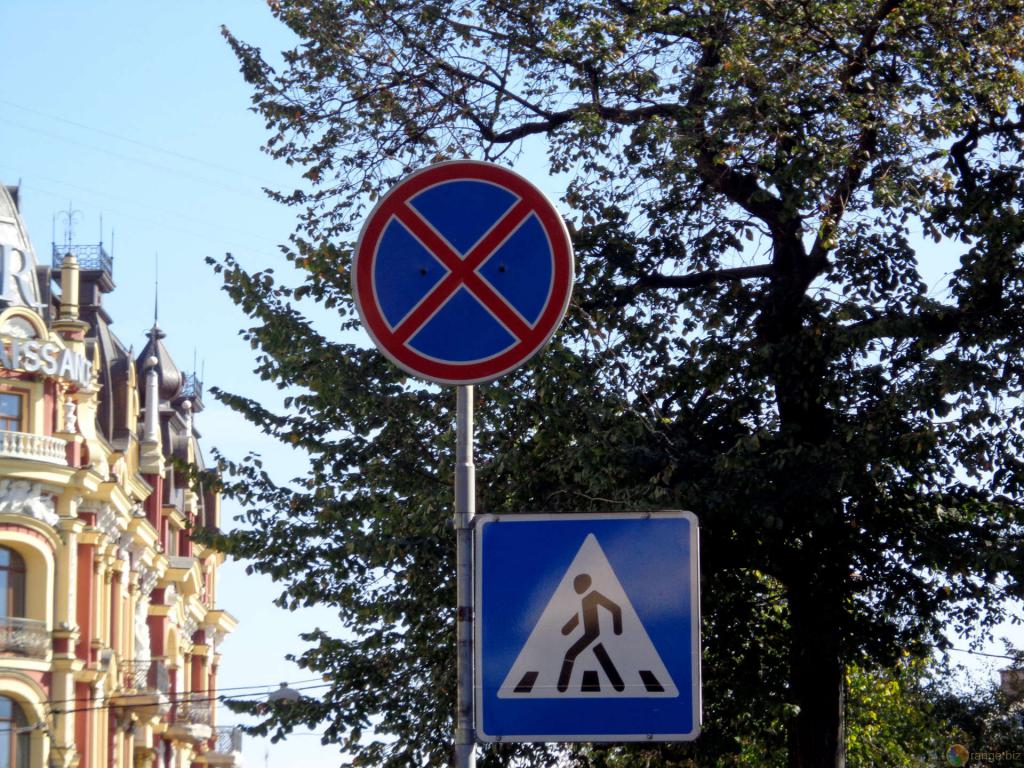A stop is a natural action when a vehicle moves on a road, which is strictly regulated by the Rules of the Road (SDA). Violation of these rules is considered a good reason to hold the driver accountable.
What is a stop
A stop is a deliberate suspension of vehicle traffic for up to 5 minutes. If necessary, the time interval may be extended if circumstances so require, for example, passengers are disembarked / boarded or goods are loaded / unloaded.
In addition to the “Stop is prohibited” sign, in the SDA there is the concept of “parking”, the differences between which each driver must understand. Parking is a stop of the car for more than 5 minutes, and the action is not connected with passengers or with the movement of cargo.
Road sign Stopping prohibited
This sign belongs to the prohibiting group and has an interesting design - a circle, with a red stroke around the perimeter, inside which there is a bright blue background, with transverse red lines in the form of the “X” symbol. This pointer is set in those places where the stopping of transport is not allowed.
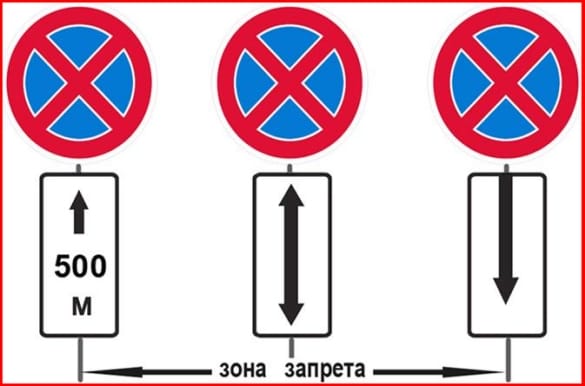
Prohibition Sign Influence Zone
The area of the “Stop is prohibited” sign starts from the point of its location and continues to the first intersection following it. But, as in any rule, there are exceptions too, they include:
- The end of the zone of validity of the sign “Stop is prohibited” may be a road sign indicating the entry or exit to the village, but only if there is no intersection.
- If during movement there is a repeated sign “Stop is prohibited” with a sign located under it, then the action ends after overcoming the distance indicated on it or immediately after the repeating sign (depends on the pointer).
- The index sign symbolizing the completion of the zone of all restrictions applies to the prohibition of stopping.
- When there is a corresponding marking next to the prohibition road sign (a yellow line on the edge of the road or in the upper part of the curb), then the zone of validity of the “Stop is prohibited” sign ends at the same level with the marking line.
Penalty for stopping under the sign
Responsibility for non-compliance with traffic rules can be different, it all depends on whether it was just non-compliance with a certain rule, or whether there are consequences associated with the rights of other drivers. So, what penalty for a stop under the sign “Stop is prohibited” could threaten the offender? It should be noted right away that most often cars left in the wrong place are simply dragged to a parking lot or taken away on a tow truck.
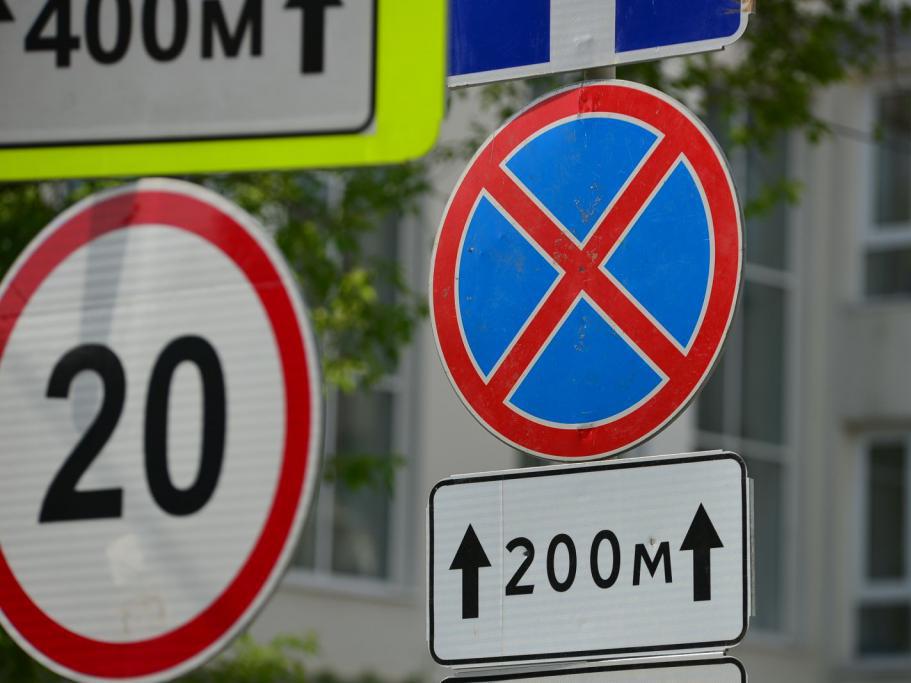
In case of violation of the ban imposed by the road sign, in accordance with clause 12.19 of the Code of Administrative Offenses of the Russian Federation, the driver will have to pay a fine of 500 rubles (in large cities of Russia - 2.5-3 thousand rubles), but the amount may be increased depending on the situation:
- If, in addition to stopping in the wrong place, the driver created an obstacle to the movement of another transport, then the amount of the fine increases to 2 thousand rubles. In addition, in this situation, it is unlikely that the car will be evacuated.
- In special places that are designed for parking and stopping cars of a privileged category of the population - disabled people - 5 thousand rubles.
- The penalty for a stop under the sign “Stop is prohibited” located in the pedestrian zone, near the boarding / boarding points for passengers of buses, trams, taxi stands and on the pedestrian walkway - 1 thousand rubles.
- A stop further than the right last row, on tram roads, non-compliance with the requirements of the road marking and the forbidden road sign - 1.5 thousand rubles.
- The fine for a stop nearby, in an underground tunnel and the formation of obstacles - 2 thousand rubles.
- A stop at the railway crossing - 1 thousand rubles or deprivation of the right to drive vehicles for a period of three to six months. In case of a secondary violation - deprivation of a driver’s license for 1 year.
Important! In the event that a stop had to be made due to a car breakdown, it is necessary to leave the roadway as soon as possible and put in place an alarm. In this case, the stop will be forced, but even under such conditions, traffic police officers may be issued a warning.
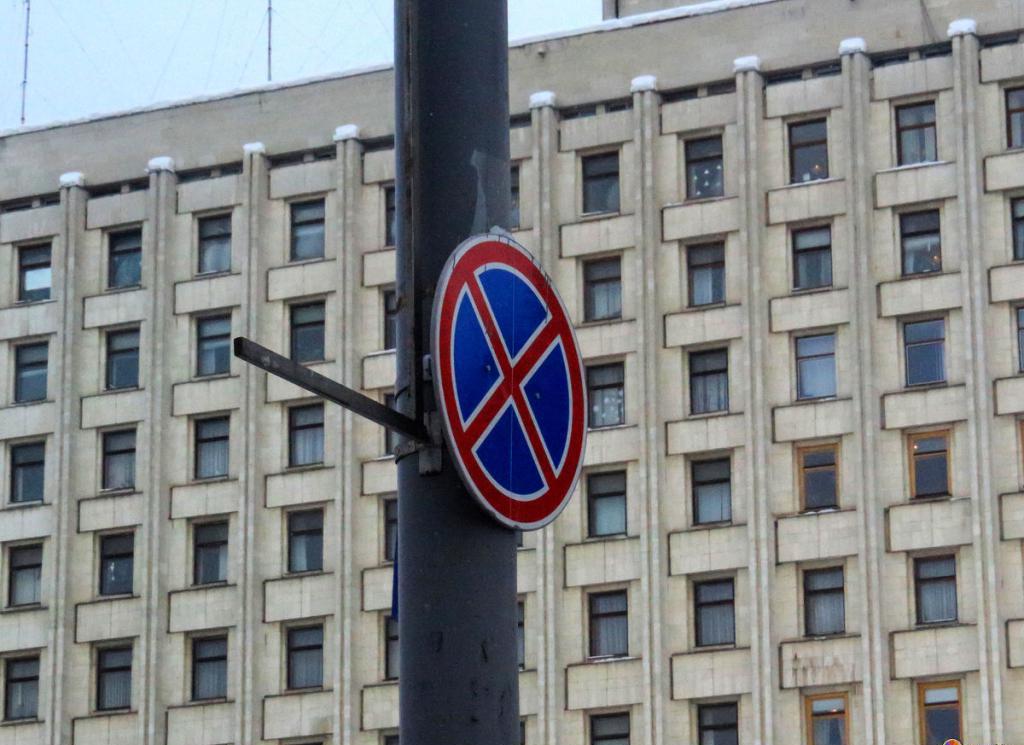
Examples of fines
Consider some situations as an example:
- On the road, the driver suddenly felt unwell, his stomach fell ill or dizziness began. He braked, pausing on the side of the road just where there is a “Stop is forbidden” marking, and triggered an alarm. After some time, the condition of the driver improved, and he was about to move in his direction, but at that time the traffic police officers arrived and still wrote him a fine of 1,500 rubles. The thing is that the driver, according to the rules, had to not only start the alarm, but also put a special sign indicating the emergency stop.
- At the exit from the courtyard of the apartment building there is a sign prohibiting a stop, and nearby taxi drivers and buses quite often stop to pick up or drop off passengers. Accordingly, for drivers of vehicles leaving the yard, buses during a stop block the observation of the oncoming lane. But, as we all know, a stop in front of the “Stop is prohibited” sign is a violation, and if an accident occurs on the road, the car owner will be guilty, and this despite the fact that the reason was a poor view.
- Take a conditional office center, the building of which is fenced. Behind it is a plot of land with a length of 5 meters, further - a sidewalk 2 meters wide, and on the roadway, 200 meters from the building, there is a sign prohibiting a stop. If an office employee leaves his car on a piece of land between the sidewalk and the fence, traffic police officers have the right to write him a fine of 3 thousand rubles. Even if the driver does not agree with such a punishment, he is wrong. According to the SDA, the fine will be issued fairly, since the rule of the “Stop is prohibited" rule applies to the area of the road where it is set. And the concept of "road" includes a lane, sidewalk and roadside.
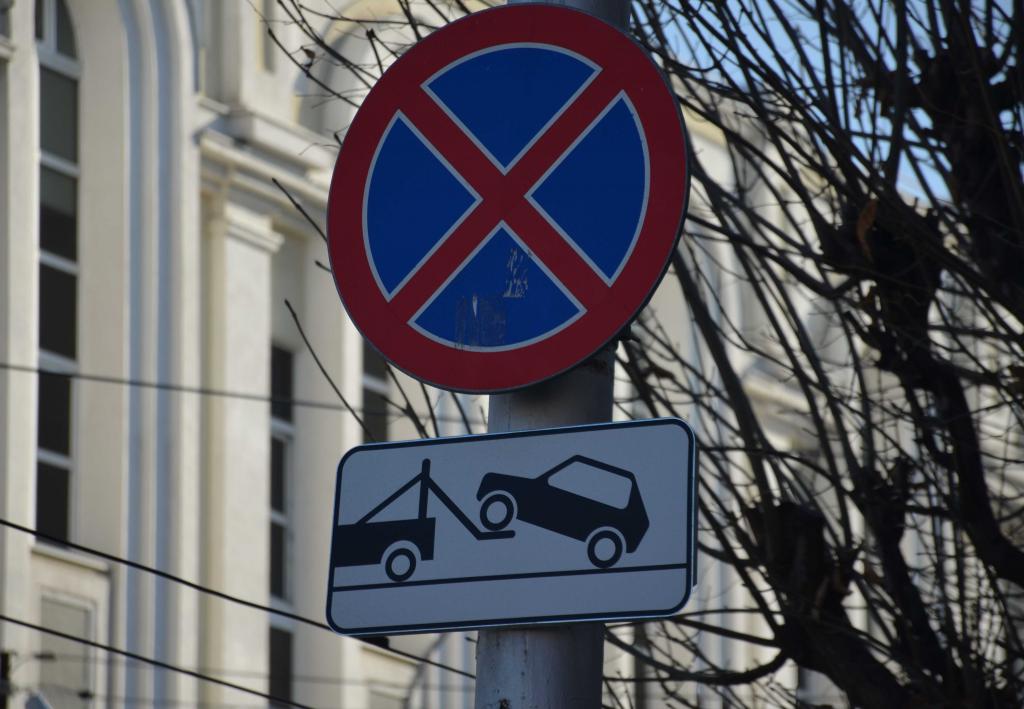
Sign Options
The sign that prohibits the stop of transport, very often comes across paired with special signs. These signs are primarily specifying or resembling a character. So, we will analyze what these images mean on an additional plate:
- Motor vehicle. This figure indicates that the ban only affects a certain type of transport, for example, KamAZ or a passenger car, a car with a trailer, agricultural equipment and more.
- The No Stop sign with a sign showing a crossed out wheelchair. At this place can be any car, except those that belong to people with disabilities.
- A sign prohibiting stopping with an arrow pointing up and numbers indicating the distance. This pointer tells the driver how far the rule is.
- The “Stop prohibited” sign with a down arrow indicates that the action section in front of the set pointer is coming to an end.
- The arrows pointing in opposite directions indicate that you are still in the zone of influence of the sign. This sign, like the previous one, works only as an application to the previously installed one.
- A horizontal line with arrows and an indication of the distance on the sign limits the stop near the facades of buildings, squares and other things. It can be depicted one or two arrows.
Some nuances
- On one-way roads, this road sign can only be installed on one or both sides. In both cases, it acts only where it is installed.
- The driver of the car can make a stop on the left side in the absence of a sign or markings. But for a truck with an allowable weight of 3.5 tons, you can stop on the left only if you need to unload or load.
- As for the stop on the left side on a two-way highway, this is not prohibited by the rules.
- A stop on the side of the road is allowed, and if it is not there, the driver can pause the movement on the edge of the roadway. In rare cases, a stop can be made on the sidewalk, but provided that there is a special sign that indicates “Parking Lot” (the image of the letter “P” on a blue background) with additional instructions in the form of signs.
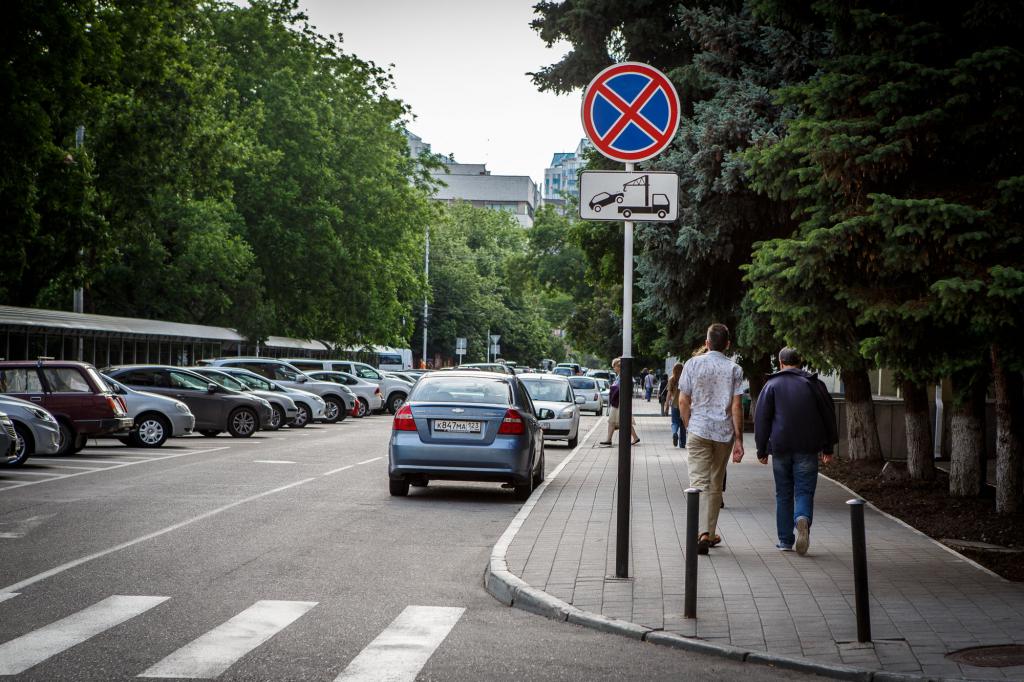
What is the difference between a stop and a parking
Such signs as “Parking” and “Stop is prohibited” in the SDA differ mainly in the purpose of the action taken. If a stop is made exclusively for boarding or boarding passengers, loading or unloading baggage, etc., then the situation “parking” includes other situations. In addition, these concepts differ in the duration of the process. For example, if the vehicle was stopped for less than 5 minutes, then this is a stop regardless of the purpose. Everything above this mark will be called parking.
The parking ban is marked with a separate road sign. It is important to remember that a stop is included in its coverage area, but parking under the sign “Stop is prohibited” is considered a severe violation.
The road sign prohibiting stopping is very similar in design and other principles to other prohibition signs. As a rule, it works until the first intersection (with separate exceptions) and is often accompanied by additional conditions and in rare cases can be “read” unclear. These episodes are separately registered in the Road Safety Rules, in the section “Stop in the Sign Influence Zone”.
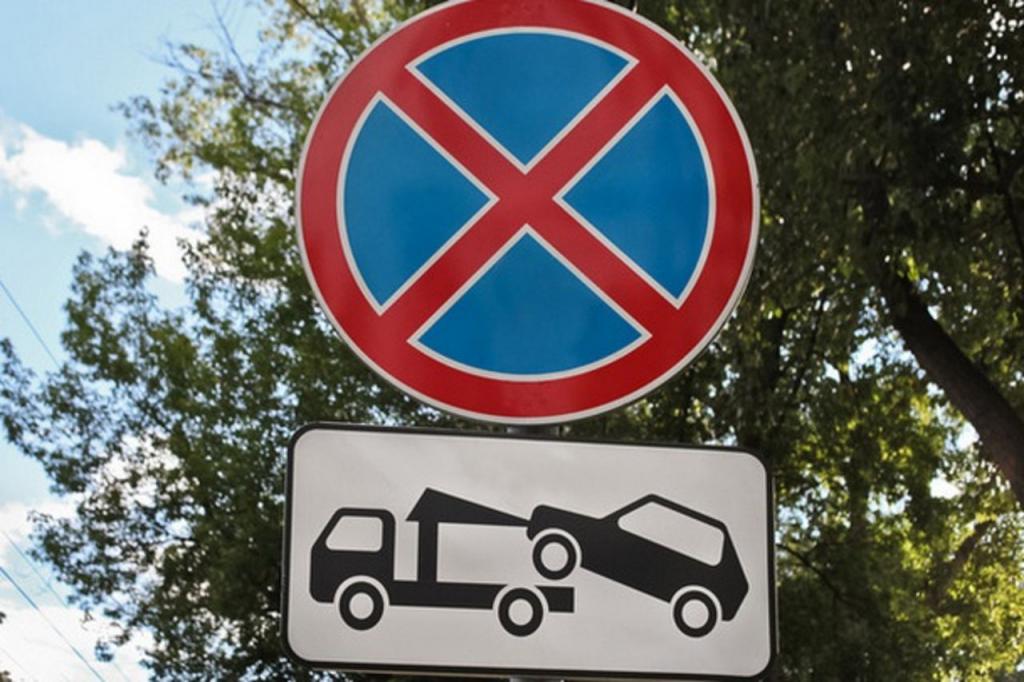
Where it is forbidden to stop driving
Sites where vehicle stops are prohibited are usually always marked with the corresponding sign, but, unfortunately, not everywhere. Therefore, the driver must remember where a stop even for a minute can become dangerous, lead to fines and unpredictable consequences. So, where it is forbidden to stop and park vehicles:
- At a distance closer than 5 meters from the pedestrian crossings and on it itself. It is allowed to linger over the passage, which is understandable - at the passage the car will impede the movement of people, and if you stop in front of it, a passing car may not see a passerby walking along a zebra when driving around.
- Not sure where stopping is forbidden? On tram tracks and close to them. The tram cannot go round anything, accordingly, your car will block the movement of public transport and violate the route schedule.
- In the strip allocated for cyclists and mopeds, as well as in the area of public transport. On these special lanes it is forbidden not only to make stops, but also to ride.
- Where else is stopping prohibited? At intersections and a distance of 5 meters from the edge adjacent to the intersection of roads in the territory.This rule does not apply to T-intersections if the driver stops in the opposite direction from the side drive when a solid line or dividing line passes between the stopping area and the side road.
- In areas obstructing road signs, traffic signals, as well as interfering with the entry / exit of other cars.
- On narrow roads where the distance between transport and a solid line or dividing strip is less than three meters. When stopping in such a zone, a motorist forces other drivers to cross a solid line, which violates the rules of the road. If there is one lane on the road, then the distance between the stop and the opposite edge of the carriageway should also be at least three meters.
- Not sure where stopping is forbidden? On the roadway near a dangerous turn or slides with visibility less than 100 meters in both directions. In this situation, the risk of a head-on collision increases. Stopping the vehicle outside the lane is not a violation.
- You can pick up / drop off a passenger at a bus stop or in a parking lot for taxi drivers, but only if you do not interfere. In other versions, stopping is prohibited at a distance of 15 meters from these objects.
- On overpasses, bridges and under them, overpasses. And also in tunnels, at the railway crossing and a distance of less than 50 meters from it.
- On the roadway, outside the boundaries of the settlements marked with the sign "Main Road", and in the area prohibiting parking.
- At discounted parking points for the disabled.
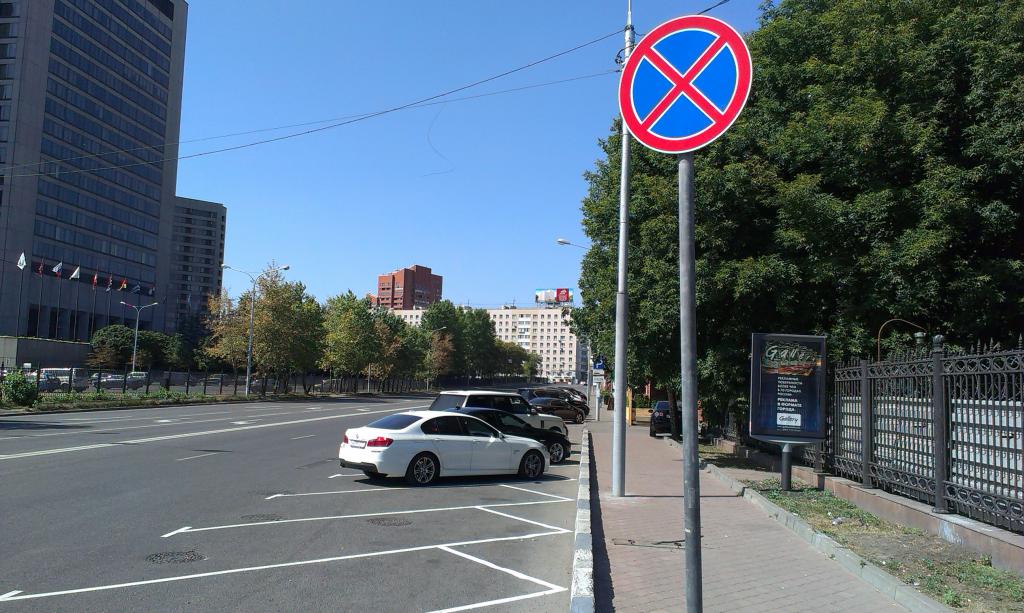
What is not a violation
On the way, anything can happen - a change in well-being for the worse, damage to the car, and more. In the event of unexpected situations, the driver has the right to stop even where it is not permitted by the rules of the road, but subject to the following conditions:
- Turn on the alarm.
- Installation of a warning triangle.
The driver must try to move the vehicle outside the prohibition sign by all available means.
